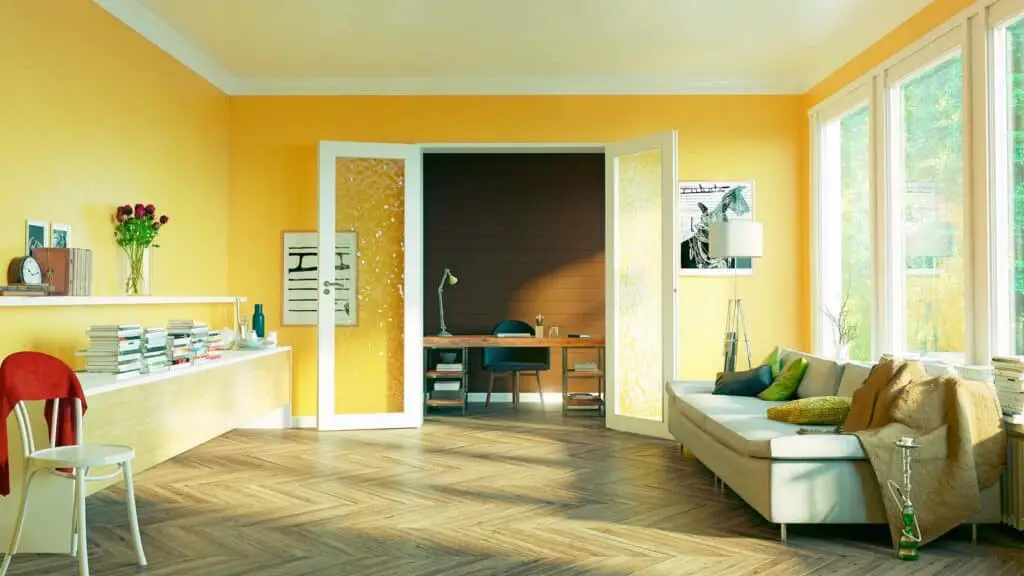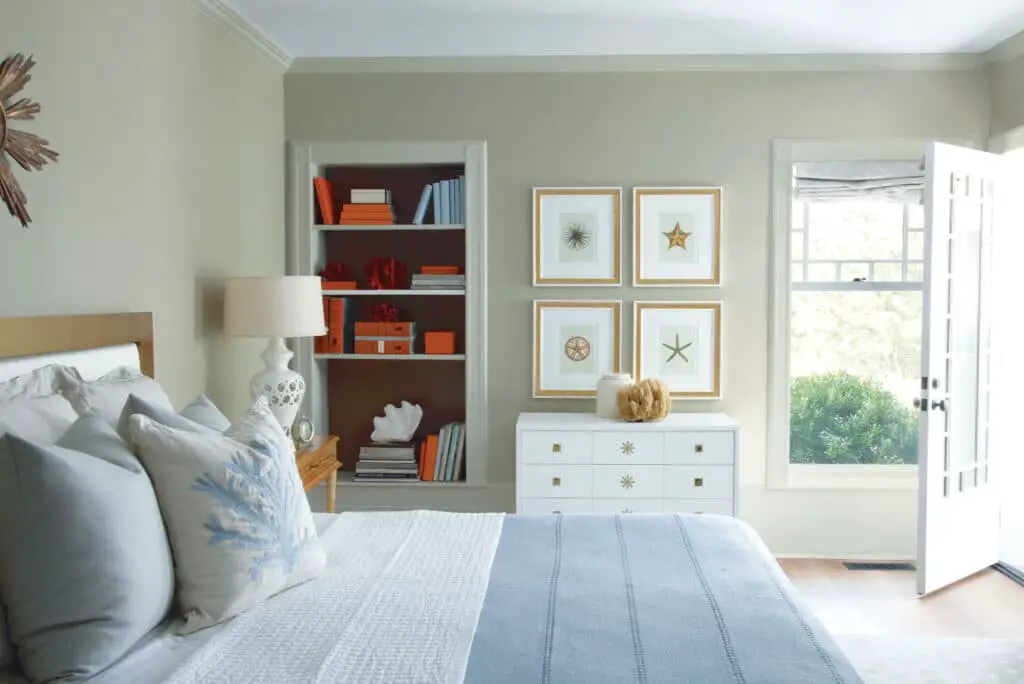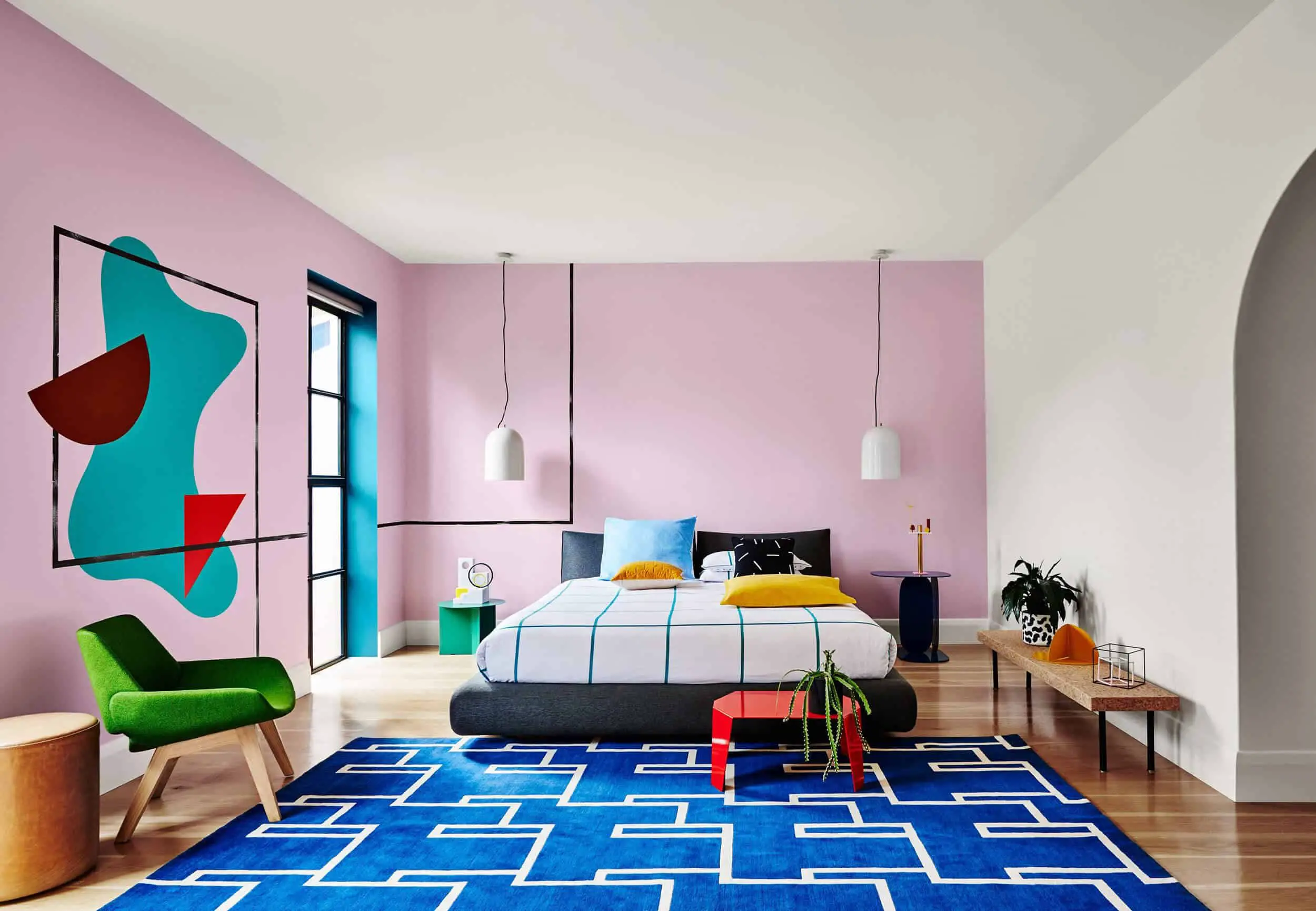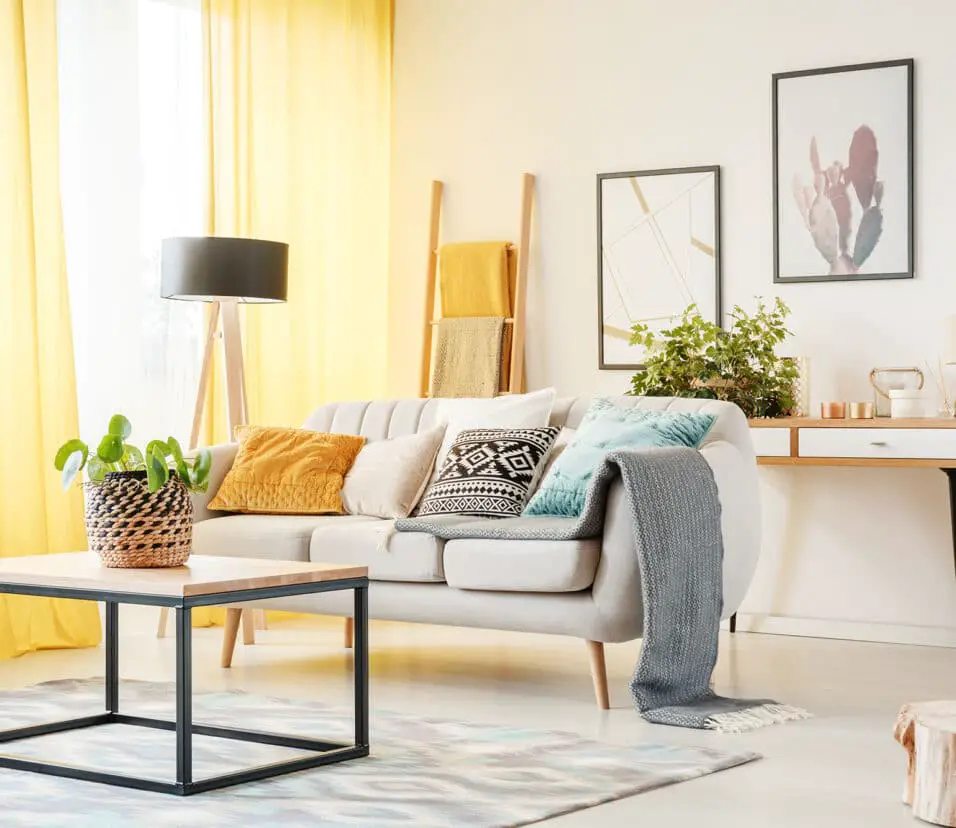What Paint Colors Make Rooms Look Bigger
Introduction
What Paint Colors Make Rooms Look Bigger: Light and neutral shades are the go-to choices when it comes to creating an illusion of space. Colors such as whites, creams, beiges, and light grays reflect more light, making the walls appear farther away. This expands the visual boundaries of the room, giving it a more open and airy feel. Light colors also have the ability to bounce light around the room, further enhancing the perception of space.
Another effective technique is to use a monochromatic color scheme, which involves selecting different shades of the same color. By using varying tones, from light to dark, you can create depth and dimension within the room. This creates a seamless visual flow, making the look bigger boundaries between walls less apparent and, in turn, making the space feel more expansive. A receding effect on walls, making them appear farther away.
Opting for paints with reflective finishes, such as satin or semi-gloss, can also contribute to the perception of a larger space. These finishes bounce light around the room, creating an illusion of depth and expansiveness. However, it’s important to note that too much shine can be overwhelming, so it’s recommended to balance reflective surfaces with matte or flat finishes on other elements in the room. To visually raise the height of a room, consider painting the ceiling a lighter shade than the walls.

What color makes a room look bigger?
Lighter paint colors like off-whites, light neutrals, pales, and pastels give the illusion of larger, brighter rooms.
Light and neutral shades are widely regarded as the top choices for making a room appear larger. Colors such as white, cream, beige, and light gray have the remarkable ability to reflect more light, giving the walls a sense of distance and making the room feel more expansive. These colors open up the space, creating an airy and fresh atmosphere. Light colors also have the advantage of bouncing light around the room, further enhancing the perception of space.
Darker Curtains
Choosing darker curtains compared to the wall color can create a different visual impact and add depth and drama to the room. Darker curtains, such as deep browns, rich blues, or charcoal grays, can create a sense of coziness and intimacy. They can make a bold statement and add a touch of elegance to the space.
Cool Colors
Cool colors, such as blues, greens, and purples, have a receding effect that can make a room feel more spacious. These colors create an illusion of distance, making walls appear farther away. Lighter shades of cool colors work particularly well in creating a sense of airiness. Cool colors are often associated with calm and serenity, contributing to a relaxed atmosphere in the room.
Natural Light
It’s important to consider natural light when choosing colors for a room. Rooms with ample natural light will benefit from lighter colors, as they maximize the brightness and create a more expansive feel. If your room lacks natural light, incorporating lighter colors can help compensate for the deficiency and make the space appear larger.
Choosing paint with reflective finishes, such as satin or semi-gloss, can contribute to the perception of a larger space. These finishes have the ability to bounce light off the walls, creating an illusion of depth and expansiveness. However, it’s important to strike a balance and avoid excessive shine, as it can be overwhelming. Pair reflective finishes with matte or flat finishes on other surfaces within the room to maintain a visually balanced and spacious feel.
Which wall should I paint to make my room look bigger?
Painting the wall on the far side of the room in a dark contrasting colour while keeping the side walls a light shade will help the room look more spacious. Another solution is to paint a single element such as wall shelving to catch the eye and make the rest of the space appear lighter in comparison.
Focus on the Farthest Wall
A common strategy is to paint the wall that is farthest from the entrance or the wall that draws the most attention in the room. By painting the wall that is in the line of sight when entering the room. You create a sense of depth and make the space appear larger. This technique draws the eye deeper into the room and visually expands the perceived boundaries.
Highlight the Longest Wall
If your room has a longer wall compared to the other walls, consider painting it to emphasize the length and create the illusion of a more elongated space. Painting the longest wall a lighter. Cooler color can make it recede and appear farther away, giving the room a sense of depth and openness. This technique can be particularly effective in narrow rooms or hallways, where enhancing the length is desirable.
Use Lighter Colors
Opting for lighter colors, such as whites, creams, pastels, or light grays, can help create the illusion of a larger space on any wall. Lighter colors reflect more light, making the room feel brighter and more open. When painting a wall with a lighter color, it visually recedes, creating. A sense of depth and expanding the perceived boundaries of the room. Consider using lighter colors on the chosen wall to maximize the impact.
Consider the natural light sources in the room. If there is a wall that receives ample sunlight, painting it in a light color. Can maximize the brightness and create an airy atmosphere. This wall will naturally draw the eye and contribute to the overall sense of spaciousness.
Do darker colors make a room look bigger or smaller?
‘Contrary to traditional thinking, dark paint allows the room to appear larger and taller than it may be. Dark colors add depth, visually enlarge the space, and make a great statement,’ says Lichelle Silvestry.
Darker colors have a higher tendency to absorb light rather than reflect it. This absorption creates a sense of depth and can make walls visually recede, giving the impression of a smaller space. When light is absorbed, the room may appear more enclosed and compact.
While darker colors can make a room feel smaller, they also create a sense of intimacy and coziness. Darker hues such as deep blues, rich browns, or charcoal grays can evoke a warm and intimate atmosphere. These colors work particularly well in larger rooms where the goal is to create a more intimate and inviting ambiance.
One way to incorporate darker colors while minimizing the impact on the perceived size of a room is through an accent wall strategy. By painting a single wall in a darker color, you can create depth and add visual interest without overwhelming the entire space. This technique can draw attention to specific architectural features or focal points and contribute. To the overall design scheme while maintaining a sense of openness.
When using darker colors, it’s important to consider contrast and balance within the room. Pairing darker walls with lighter elements, such as furniture, flooring, or ceiling, can create a visual contrast that prevents the space from feeling too enclosed. The strategic use of lighter colors in furniture or accessories can also help. To balance the overall design and maintain a sense of openness.
What colors make rooms look brighter?
Cooler paint colours help walls to recede, making the room feel more spacious and light. Go for pale shades of grey and blue for maximum lightening effect. If it’s warmth you’re after, don’t be afraid to use light terracotta. Yellow paint colours – a sunny hue can brighten and warm a dark, dingy space.
White is the ultimate color for creating a bright and light-filled room. It reflects light and maximizes brightness, making walls appear more expansive and airy. Different shades of white, from crisp pure white to softer off-white tones, can be used to create varying effects. White also provides a neutral backdrop, allowing other elements in the room to stand out and contribute to the overall brightness.
In addition to white, light neutral colors such as beige, cream, and light gray can also make a room look brighter. These colors reflect light and create a clean, fresh atmosphere. Light neutrals have the advantage of being versatile and can be paired. With a wide range of accent colors and decor to add visual interest while maintaining a bright and open feel.
Soft pastel colors, such as pale yellow, mint green, and baby blue, can infuse a room with a delicate brightness. These gentle hues have a luminous quality that adds a touch of color while maintaining a light and airy ambiance. Pale pastels work particularly well in rooms with abundant natural light. As they enhance the brightness and create a soothing and refreshing atmosphere.
While not technically a color, incorporating mirrored finishes or reflective surfaces can significantly enhance the brightness of a room. Mirrors reflect light and create an illusion of space and openness. You can use mirrors strategically to bounce light around the room. Amplifying the natural and artificial light sources and making the space appear brighter.
What colors make a room look expensive?
White. Warmer creamier whites can make your house look very spacious and clean. Bold, crisp white color can do this with ease. Watch your room turn into this luxurious space at the blink of an eye.
Classic neutral colors, such as shades of beige, taupe, and gray, can convey a timeless elegance and understated luxury. These hues create a refined and sophisticated backdrop that allows other elements in the room to stand out. Consider using neutral colors on walls, upholstery, or large furniture pieces to create a sense of timeless elegance and a high-end aesthetic.
Incorporating metallic accents, such as gold, silver, or bronze, can instantly elevate the look and feel of a room. These colors add a touch of glamour and luxury by reflecting light and creating a sense of richness. Metallic finishes can be incorporated through accessories, lighting fixtures, hardware. Even as accents within the paint color itself, such as metallic-infused paints or wallpapers.
Deep shades of gray and charcoal can create a sense of depth and sophistication within a room. These colors have a sleek and modern appeal, lending an air of luxury to the space. Deep grays and charcoals work particularly well in contemporary or minimalist designs, creating. A clean and sophisticated backdrop that allows statement pieces or artwork to shine.
Colors inspired by nature, such as deep browns, warm terracottas, or burnt oranges, can add a luxurious and earthy touch to a room. These rich earthy tones create a sense of warmth and coziness, while also exuding an upscale and inviting atmosphere. Consider incorporating these colors through accent walls, textiles, or furniture to add depth and a high-end feel.

What colours make a small room feel bigger?
It is important to consider the right paint finishes when choosing colors to make a small room look bigger as Helen Shaw, director of Benjamin Moore highlights. ‘Lighter paint colors like off-whites, light neutrals, pales, and pastels give the illusion of larger, brighter rooms.
White is a particularly effective color for creating the illusion of space in a small room. It reflects light, maximizes brightness, and makes walls recede, visually expanding the boundaries. White provides a clean and fresh backdrop, allowing other elements in the room to stand out and contribute to the overall sense of openness.
Using a monochromatic color scheme in a small room can create a seamless visual flow and make the space feel larger. This involves selecting different shades of the same color, from light to dark. By utilizing varying tones, you create depth and dimension within the room, blurring the boundaries and creating a more expansive visual perception.
These colors create a sense of tranquility and openness, evoking a spacious and calming atmosphere. Cool colors work particularly well in rooms with ample natural light, as they complement the brightness and create a harmonious environment.
While not strictly colors, incorporating mirrors and reflective surfaces can greatly enhance the perceived size of a small room. Mirrors reflect light and create an illusion of depth, making the space feel larger and more expansive. Consider placing mirrors strategically to bounce light around the room and amplify the sense of spaciousness.
In a small room, it’s generally recommended to limit contrast between walls, ceiling, and trim. Opt for a more cohesive color palette to create a seamless visual flow, minimizing the delineation between surfaces. This helps to reduce visual interruptions and makes the space appear larger.
Do warm colors make the room seem bigger?
Light and Warm Paint Colour
Whereas light and cool can make a space feel bigger, light and warm can work if you want it to feel bright and big, but still warm and inviting! Sherwin Williams Creamy is another light, bright and warm paint colours (that isn’t obnoxiously yellow).
To counterbalance the visually advancing effect of warm colors, it’s important to incorporate cool and light colors in the room as well. Use cool colors, such as blues and greens, on adjacent walls or in the furnishings to create a visual contrast that adds depth and makes the room feel more open. Light colors can also be employed on trim, ceilings, and other surfaces to create a sense of brightness and expansiveness.
Perception of Warm Colors
Warm colors have a visually advancing effect, which means they tend to make objects or surfaces appear closer. They have a tendency to visually enclose a space, making it feel smaller and more intimate.
Lighter Shades and Brightness
Lighter shades of any color, whether warm or cool, have a natural tendency to make a room feel brighter and more open. Light colors reflect more light, maximizing the brightness within a space. When combined with cool colors, lighter shades can enhance the perception of space by creating a sense of airiness and an overall more expansive feel.
Consider the size and function of the room when deciding to use warm colors. In smaller rooms, it may be best to use warm colors sparingly or as accents to avoid overwhelming the space. In larger rooms, warm colors can be used more generously, creating a cozy and intimate atmosphere. The purpose of the room should also be taken into account. Warm colors can work well in spaces where a sense of warmth and comfort is desired, such as living rooms or bedrooms.
What makes a room look bigger?
Any room will look larger if it’s well-lit, either by natural light or artificial lighting. Get rid of heavy draperies, and open up the windows to let the light of the outdoors into the space. Add more lamps or install track lighting or recessed lighting.
Maximizing natural light is essential in making a room appear larger. Keep windows unobstructed and opt for sheer or light-filtering window treatments to allow as much sunlight as possible into the room. Natural light not only brightens up the space but also creates a seamless connection with the outdoors, making the room feel more open and airy.
Strategically placing mirrors and incorporating reflective surfaces can significantly increase the sense of space in a room. Mirrors reflect light and create an illusion of depth, visually expanding the boundaries. Place mirrors opposite windows to reflect natural light, or use mirrored furniture and accessories to add depth and reflectivity.
Keeping a room clutter-free and adopting a minimalist approach can make it appear larger and more spacious. Remove unnecessary items, furniture, and excessive decorations that can make the room feel cramped. Embrace a streamlined design with functional furniture pieces that serve a purpose without overwhelming the space.
Proper furniture placement can play a significant role in maximizing the perceived size of a room. Avoid blocking pathways and create an open flow by leaving enough space between furniture pieces. Use furniture that is proportionate to the room’s size, and consider using multifunctional pieces that can save space.

Conclusion
Light and neutral colors, such as whites, creams, beiges, and light grays, are effective in reflecting light and making walls appear farther away. This creates a sense of openness and airiness within the room. Monochromatic color schemes and such as blues and greens, also contribute to the perception of space by creating depth and receding walls.
Using reflective finishes on walls and ceilings can further enhance the sense of expansiveness, as they bounce light around the room and add dimension. Additionally, considering the ceiling color as a lighter shade than the walls can create the illusion of higher ceilings, contributing to the overall spaciousness. These colors create a sense of tranquility and openness, evoking a spacious and calming atmosphere. Paint colors particularly effective in rooms with ample natural light, as they complement the brightness and create a sense of harmony.
While the focus is primarily on light and neutral colors, incorporating pops of accent colors through decor and furniture can add visual interest without compromising the perceived size of the room. This technique draws the eye upward and creates the illusion of higher ceilings, adding to the overall sense of spaciousness.




